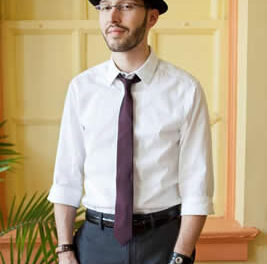One of the more popular of the Eastern Music Festival‘s innovations in recent years has been an evening of Baroque music performed in the First Presbyterian Church in downtown Greensboro. This magnificent space, with its uniquely decorated exposed wooden beams, has hosted both Early Music and modern instrumental programming. This concert fielded a skilled chamber orchestra consisting of eight violins, two cellos, two violas, a double bass, and a harpsichord. Four-member violin sections were seated on either side of music director Gerard Schwarz’s podium. All the musicians were members of the Festival’s faculty as well as the all-professional Eastern Music Festival Orchestra heard every Saturday night throughout the festival.
J. S. Bach’s Concerto No. 1 in A minor for Violin, S. 1041 is thought to have been composed during the composer’s most secular period when he was Kapellmeister to Prince Leopold of Anhalt-Cöthen (1717-23). The six Brandenburg Concertos date from this fecund posting. Bach is known to have composed many more violin concertos than the surviving three. The composer borrowed heavily upon Antonio Vivaldi’s model in which the soloist is treated as a component of the orchestra instead of standing out in stark contrast. The ritornello structure has movements organized in a fast-slow-fast setup. In Michael Talbot’s article “Concerto” in the Oxford Composer Companions: J. S. Bach (ed. Malcolm Boyd) the author stresses Bach emphasizes thematic and textural integration above the contrast and virtuosity of Vivaldi’s use of the ritornello form.
Festival Orchestra Associate concertmaster Jessica Guideri was the superb soloist in a committed and vital performance of Bach’s First Violin Concerto. Her intonation was immaculate and her sweet warm tone was most winning. Schwarz maintained ideal balances between soloists and ensemble. Gideon Rubin’s spare harpsichord continuo was usually audible in the denser texture of the outer movements. The emotional core of the work is the slow movement in the relative major key of C. A well-chosen tempo seemed to suspend time as Guideri wove a seamless melodic line.
The remaining two Bach works on the program were reconstructions of his violin concertos from surviving arrangements by Bach for multiple harpsichords. Bach’s Concerto in C minor for oboe and violin, S. 1060R has been recreated from the composer’s Concerto in D minor for two harpsichords. It is in the standard three fast-slow-fast movements. Randall Ellis played his oboe with a beautifully focused and mellow, warm tone. His breath control was astonishing and his phrasing was very effective. Festival Orchestra concertmaster Jeffery Multer’s full, dark violin tone provided strong contrast to Ellis’ bright sound. The middle slow movement was a delightful showcase for the soloists with its extensive pizzicato string accompaniment. The finale was lively with well sprung rhythms and its interplay between the solo oboe and violin.
Bach’s Concerto in D minor for three violins, S. 1064R has been reconstructed from the composer’s Concerto in C for three harpsichords, S. 1064. Schwarz’s three soloists were Festival Second Violin Principal Randall Weiss, Jessica Guideri, and Second Assistant Concertmaster Shawn Weil. The concerto opened with full, rich string texture and lively tempo. Each soloist entered in turn and provided contrast over the course of the inventive give-and-take. A striking feature of the intimate slow movement was the unusual pairing of a violin soloist with another orchestra player such as Weiss and Weil with Neal Cary’s resonant cello or Weiss and Guideri with Meredith Crawford’s plangent viola. The vital last movement gave all three soloists ample room to display their skills. Weil had served as concertmaster for the rest the concert program.
The selection of Vivaldi’s Concerto in B minor for Four Violins and Cello, RV. 580 was an apt choice for this mostly Bach program since the German master created six of his ten keyboard transcriptions from the Italian master’s L’Estro Armonica, Op. 3 from which this concerto was taken. This is a lively, winning concerto that provides Talbot’s “contrast and virtuosity” in spades! The splendid quartet of violin soloists consisted of Penny Kruse, Yuka Kadota, Jenny Gregoire, and Diana Tsaliovich. Balance and intonation were excellent throughout. The interplay between each of the four soloists was striking as was the pairing of soloists with the cello or viola from time to time. This was a thoroughly pleasing evening of music not often heard in live performance.












